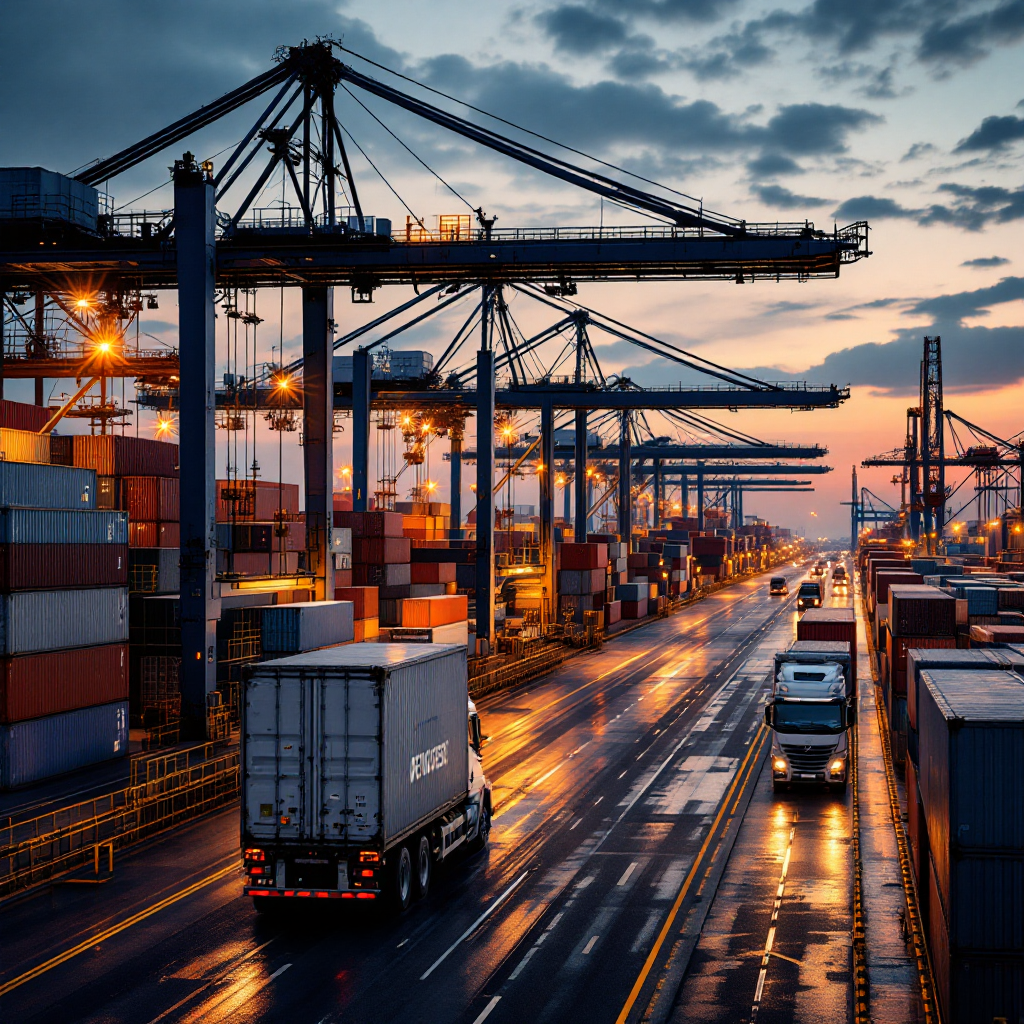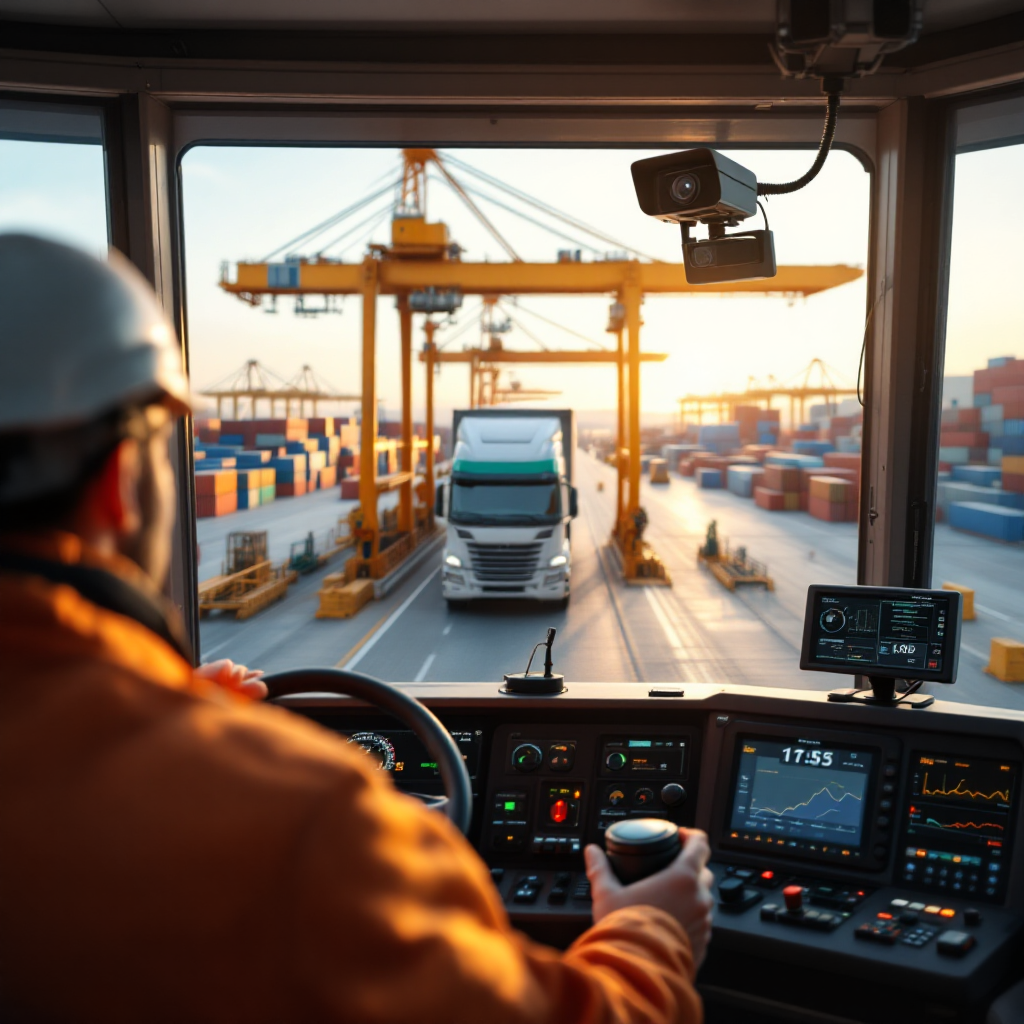AI Video Analytics, Port and Terminal Overview
AI video analytics refers to systems that combine MACHINE LEARNING and computer vision to convert video into structured, searchable intelligence. AI models spot objects, read markings, and classify behaviours. For ports and container terminals this technology turns cameras into sensors. It allows supervisors to track container movements, monitor vehicle lanes, and detect safety issues in real time. Also, AI reduces the manual review of video footage and speeds decision cycles.
Ports are busy places with cranes, trucks, and people moving at once. Terminals must coordinate loading, stacking, customs checks, and hinterland handoffs. Therefore, video intelligence helps unify these tasks. It feeds dashboards that show dwell time, equipment status, and gate queue length. In practice, terminals use edge inference on IP CAMERAS and on-prem servers to keep data private and comply with EU rules. Visionplatform.ai helps ports reuse their VMS video and stream events to dashboards, so cameras work beyond security alone.
The market for AI video is growing fast. The AI video analytics market was valued at about USD 9.40 billion in 2024 and is projected to reach USD 11.99 billion by 2032 with a CAGR of 3.09% [source]. More broadly, the AI video market could exceed USD 42.29 billion by 2033, at a CAGR near 32.2% [source]. As a result, many ports and terminals budget for deployment and upgrades.
Advanced AI and deep learning drive object detection and anomaly recognition. For terminal operators the benefits of AI are practical. For example, analytics can reduce truck turnaround time, improve stacking logic, and cut manual inspections. Additionally, this cutting-edge approach supports predictive maintenance and resource allocation. Finally, the integration of ai with terminal operating systems makes operational workflows more efficient and auditable.
AI-Powered Video Analytics for Real Time Monitoring
AI-powered systems analyse live VIDEO FEEDS to produce alerts and events. These systems run object detection, license plate recognition, and loiter detection on cameras at gates and yards. In practice, live video feeds are processed at the edge to deliver real-time alerts without sending raw video to the cloud. This real-time capability reduces response times and helps staff act before small problems escalate.
Systems spot anomalies such as unauthorized access, equipment faults, or unusual container movement. When an anomaly appears, the system sends an alert to the right operator or security team. This proactive approach shortens the time between detection and response. In one operational trial at a major terminal, an ai-powered camera array reduced gate queueing by alerting staff to mis-routed trucks. The Port of Los Angeles case shows how autonomous cranes and guided vehicles use camera input to operate safely and efficiently; such examples highlight how ports worldwide adopt autonomy to increase throughput [source].
AI algorithms also support a proactive approach to maintenance. For example, video monitoring can detect container handling equipment wear and provide early warnings. Then, teams schedule repairs before failures cause costly downtime. Visionplatform.ai supports such use by streaming structured events over MQTT for BI and SCADA. This lets operations teams act on camera-derived KPIs and view camera health alongside other sensors. Moreover, the combination of video AI and predictive analytics lets terminals balance throughput and asset life, while keeping data local for GDPR readiness.

AI vision within minutes?
With our no-code platform you can just focus on your data, we’ll do the rest
Port Security with AI-Powered Video Analytics
Port security faces theft, smuggling, and complex access control challenges. AI-powered video analytics strengthens perimeter checks and gate operations. It can detect unauthorized access and flag suspicious behaviour close to sensitive assets. For example, facial recognition and license plate functions reduce tailgating at gates, while object detection highlights packages left in restricted zones. Governments and terminal operators deploy these tools to improve situational awareness and ensure compliance with safety and customs rules [source].
An ai-powered video analytics platform will typically include advanced video features such as license plate recognition and loiter detection. These features allow security teams to respond faster when someone attempts a breach. Also, the technology can integrate with access control and alarm systems so staff get a single, actionable view. This integration of ai with existing VMS and access control improves adherence to safety and audit trails.
Terminals benefit from reduced false alarms. Custom AI models trained on site-specific footage spot local uniforms, vehicles, and behaviours. Visionplatform.ai lets teams retrain models on-site and keeps video data private. This approach reduces vendor lock-in and avoids sending sensitive video footage to third-party cloud services. As a result, terminals can meet compliance with safety and regulatory regimes while still using cutting-edge ai technology to enhance security.
Finally, the platform approach empowers security teams to share events with customs, port police, and operations. In short, AI enhances port security by combining real-time alerts, object detection, and scalable deployment. The result is better situational awareness and fewer security breaches.
AI Video for Cargo Handling and Operational Efficiency
AI video helps track cargo from gate to stack. Cameras and AI models read container numbers, detect container damage, and record handling events. This creates a searchable log of moves and incidents. Operators then reduce manual checks and find misplaced containers faster. Also, video-derived metrics feed into scheduling tools and help optimize yard locations for faster pickup.
When cargo is scanned visually, terminals avoid mis-picks and improve the optimal container placement. For instance, an intelligent video workflow can identify an incoming container, check its declared contents, and flag mismatches. Then, staff can inspect suspicious loads before they enter the terminal. This proactive approach lowers risk and improves customs processing.
AI analytics also improve operational efficiency by cutting dwell time. By automating gate checks and automating stack assignments, terminals speed truck processing and increase throughput. Data shows that adoption of advanced analytics in terminals translates to measurable gains in productivity and cost savings. Moreover, predictive analytics can forecast peak times, allowing better resource allocation such as crane allocation and labour shifts. The net effect is smoother workflows and fewer crane idle hours.
In practice, integration matters. Terminals must integrate the video analytics platform with the TOS and VMS. Visionplatform.ai focuses on that integration by streaming structured events for OEE and KPI dashboards. This lets teams track performance in minutes rather than hours. Also, with scalable edge inference, terminals avoid large upfront investment in cloud processing while keeping data under their control. Overall, AI-powered solutions help terminals optimize stacking, lower damage rates, and improve cargo visibility across the supply chain.

AI vision within minutes?
With our no-code platform you can just focus on your data, we’ll do the rest
Integrate Intelligent Video in Terminal Operations
To integrate AI video systems with terminal management software you need robust interfaces. First, link the video analytics platform to the VMS and the TOS. Second, stream structured events into dashboards and SCADA via MQTT or webhooks. Visionplatform.ai supports these paths and enables local model retraining so detectors match site rules. This reduces false alerts and speeds adoption.
Data quality and sensor reliability are critical. Poor camera placement or low-light video reduces detection accuracy. Therefore, terminals must audit IP CAMERAS, ensure proper exposure, and provide overlapping views on critical gates. Next, network bandwidth must support real-time monitoring and event streaming. Many deployments use on-prem GPU servers or edge devices like NVIDIA Jetson to keep analysis close to the cameras and preserve privacy.
Intelligent video workflows include predictive maintenance and workflow ALERT pipelines. For example, video AI can detect erratic crane motion and generate a maintenance ticket. Then, predictive analytics predicts component wear and avoids breakdowns. Also, workflow alerts notify supervisors when stacking patterns will cause delays, so crew can adjust assignments proactively. This proactive approach reduces downtime and improves operational performance.
Finally, integration of ai requires governance. Terminals should record model changes and event logs for audit. This ensures ensuring compliance with safety and regulatory regimes. With the right architecture, deployments scale from a handful of streams to thousands. As a result, intelligent video becomes a sensor layer that powers operations, security, and business intelligence.
AI Delivers Operational Insights for Port Management
AI delivers dashboards and alerts that help port managers make faster decisions. These dashboards combine video data with TOS metrics to show where delays start. Also, they surface actionable insights about crane utilisation, gate performance, and yard density. As managers view trends, they can reassign labour or shift equipment to match demand.
Beyond throughput, AI supports safety in ports and builds a culture of safety. Video AI can detect unsafe behaviours and PPE violations. Then, the system issues real-time alerts so supervisors can intervene immediately. This ensures the safety of workers and reduces incidents. Also, video intelligence documents incidents and helps with adherence to safety investigations and claims.
Research points to continued improvements. Challenges remain in sensor reliability, edge training, and integration with legacy systems [source]. Still, the power of artificial intelligence and ai and deep learning is proving useful in predictive maintenance, resource allocation, and compliance. For example, predictive analytics can forecast equipment wear on container handling equipment and trigger inspections before faults appear.
Looking ahead, smart ports will connect video AI to traffic systems, hinterland scheduling, and customs platforms. This will let managers optimize berth arrival, reduce emissions, and run operations with unparalleled precision. As ports adopt these tools, they will find a balance between upfront investment and long term savings. Finally, adoption hinges on scalable architectures and policies that keep data private while enabling operational gain [source].
FAQ
What is AI video analytics for ports?
AI video analytics for ports uses machine learning and computer vision to turn camera streams into actionable events. It supports security, cargo handling, and operational dashboards that help staff make faster decisions.
How does real-time monitoring work in terminals?
Real-time monitoring analyses live video feeds at the edge or on servers and sends alerts when anomalies appear. This lets teams respond immediately to unauthorised access, equipment faults, or safety breaches.
Can AI improve port security?
Yes. AI helps detect unauthorized access, loitering, and suspicious loads. It can also automate license plate or license plate recognition at gates to speed checks and reduce tailgating.
Is it possible to integrate video analytics with terminal software?
Yes. Modern platforms stream structured events to TOS, VMS, and BI systems via MQTT or webhooks. This integration lets operations use camera events for scheduling and alerts.
Do terminals need new cameras for AI?
Not always. Many systems work with existing IP CAMERAS, though camera placement and image quality affect accuracy. Upgrades can help where lighting or angle issues persist.
How does AI help reduce container damage?
AI can spot container damage during handling and log occurrences automatically. Then, teams can route damaged units for inspection, which reduces hidden costs and claims.
What about data privacy and compliance?
On-premise or edge processing keeps video data local and reduces exposure to third-party clouds. This approach supports compliance with GDPR and other safety and privacy rules.
Can AI support predictive maintenance in ports?
Yes. Video-based predictive analytics can detect early signs of wear on cranes and trucks. Predictive alerts schedule maintenance before failures occur, lowering downtime.
How quickly do ports see ROI from AI video?
Return depends on scale and use cases. Gate automation and reduced dwell time often show benefits within months, while full TOS integration and predictive workflows deliver larger savings over time.
Where can I learn about platform solutions for terminal analytics?
Visionplatform.ai offers solutions that integrate with VMS and stream events for operations. For related applications, see our pages on ground handling and platform edge safety detection for practical deployments.

